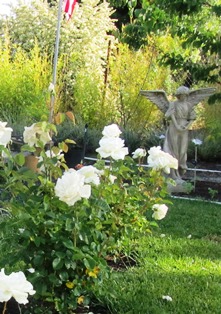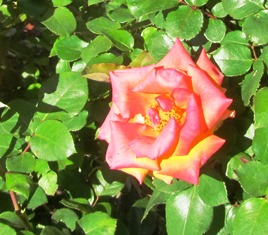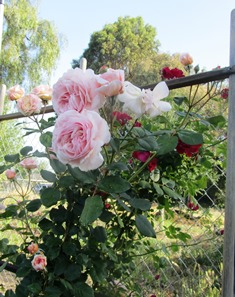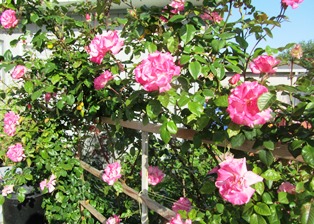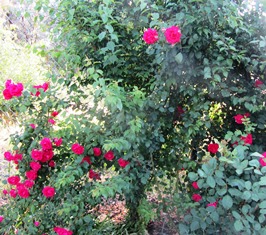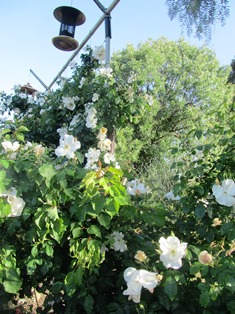A Rose Bush for Your Valentine?
If your sweetheart is a gardener, why not give a gift that keeps on giving? Instead of a single rose or a bouquet, consider giving a bare-root rose bush. A plethora of plants are arriving in garden centers now.
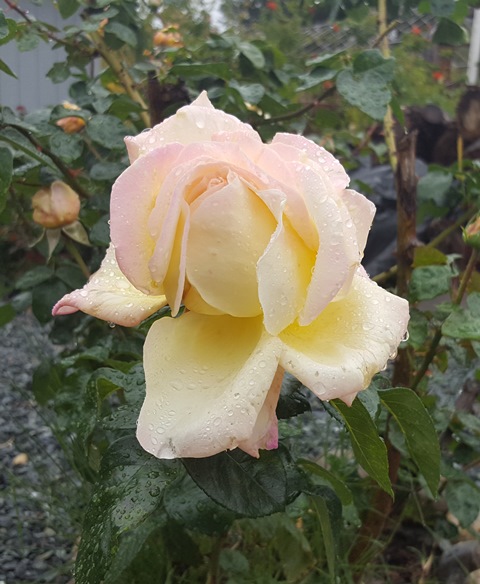
Many modern roses have been bred to bloom repeatedly throughout spring, summer, and fall, even into December in milder climates. With gorgeous single buds on tall stems or dazzling sprays of blooms, roses are the perfect cut flowers for indoor bouquets.
With the traditional “lover’s” day just around the corner, now is the time to decide on what type of rose bush to give your valentine. Bare-root season is the best time to purchase rose bushes. In a couple of months prices go up as unsold roses are re-potted in containers of soil with nutrients.
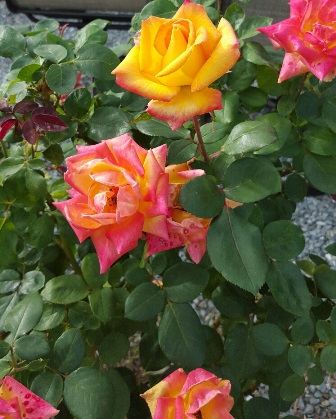
well-known “Ketchup & Mustard” floribunda
At the most basic level, roses are classified into three main categories: wild roses, old garden roses bred before 1867, and new roses bred or hybridized for modern gardens for fragrance, bloom size, color, and other desirable characteristics.

Before you buy, consider what characteristics you would like in a rose and choose a type that matches your purpose.
Modern varieties have been cultivated to produce roses to repeat bloom, bloom as single buds, or bloom in sprays. Some are fragrance-free; others offer a heady scent. Many roses have prickles (sometimes called thorns although technically they are not). The blooms of roses vary in size, shape, and number of petals as well as color. Some have a single color. Others display two or more colors as the blooms open and age.
Consider how much space your sweetie might have in his or her garden for growing the rose. Climbers need support like a wall, fence, or a trellis. Certain roses aren’t fussy about soil, other cultivars have specific needs. Be informed before you buy. Be sure to read the rose label for information about the cultivar.
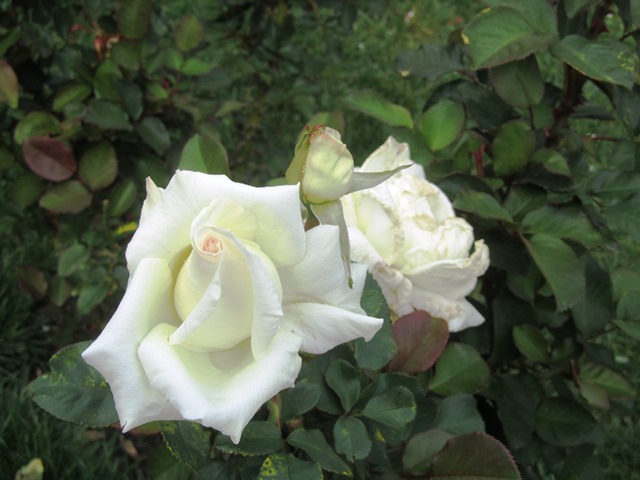
If you enjoy reading about gardening and country living and also love a good story, check out my Henny Penny Farmette series of cozy mysteries. All are available online and wherever books are sold. They include, A BEELINE TO MURDER, THE MURDER OF A QUEEN BEE, and A HIVE OF HOMICIDES.
Speaking of Roses
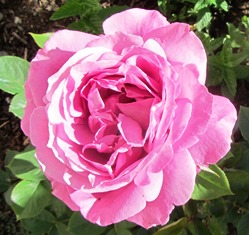
This candy-stripe rose was a gift from a friend–a cutting from her rose that became a large bush in my garden
If you love roses like I do, you probably already have a few growing in your garden. Perhaps you also look forward during long winter evenings to perusing the offerings in the catalogs of rose growers and dreaming of new varieties to plant in the spring.
Whether you are new to growing roses or have been gardening with them for a while, a review of types and species might be in order, especially before you plan a visit to your local gardening center. Bare root roses will start arriving in about three weeks here in Northern California.
TYPES OF ROSES
Roses fall roughly into four general categories: Bush Roses (this is the largest group and includes hybrid tea, polyantha, floribunda, heritage or old rose, miniature, and tree roses), Climbing Roses (large-flowering climbers have canes to 10 feet, ramblers have canes to 20+ feet and small flowers in early summer), Shrub Roses (upright growth habit reaches 4 to 12 feet and may only bloom once during summer), Groundcover Roses (also called carpet roses, these grown in low mounds and can bloom only once or repeatedly).
SPECIES of ROSES
Alba–These beauties are white or palest pink with gray-green foliage.
Bourbon–Repeat bloomers that have a wide height range and glossy green foliage.
Centifolia–These stunning beauties were favored by the Dutch master painters. Centifolia roses contain many petals on cold-hardy plants that grow 4 to 8 feet tall.
Climbers–These roses come in a wide variety of bloom type and color and have long, arching canes.
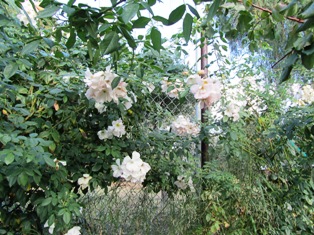
Climbing Sally Holmes produces large sprays of white to palest pink roses along the back fence of our property, from early spring to frost
Damask–May bloom only once although some varieties will repeat; the flowers are white or soft pink and fragrant. For centuries, this was the rose species used to produce Attar of Roses.
Florabunda–Produces sprays of roses and is a repeat bloomer.
Grandiflora–Similar to hybrid tea roses, the grandiflora blooms on long canes and is associated with the high-centered blooms so often seen in floral shops.
Hybrid Gallica–An old rose that blooms in the spring; flowers are pink or red or even striped and emerge on plants that stand about 4 feet tall.
Hybrid Perpetual–These roses were especially loved in the 1800’s for their red and pink color, repeat flowering, and height of six feet.
Hybrid Tea–Blooms on long canes as a single bloom or sprays of flowers.
Polyantha–Smaller blooms than the florabundas but can produce large sprays in repeated flowering.
Noisette–Plants tend to be large and often sprawl but can produce fragrant clusters of blooms and are repeat-flowering. They are sensitive to cold and frost.
Miniature–Small roses ranging in height from 1 to 3 feet with miniature flowers and foliage.
Shrub–Hybrid rugosas are an example of the shrub varieties (of which there are many). Often these roses have lots of prickles.
Tea Roses–These plants have quite large blooms, but the drawbacks include weak canes and a susceptibility to frost and cold. Their height and bloom color can vary widely.
Climbing Roses Put On a Show for Spring
I confess I’m a rose lover. This time of year, the climbing roses we’ve planted are clambering up on wooden trellises, chain link fences, and even the wall of the chicken house, putting on a spectacular display. What’s not to love?
Here in Northern California’s inland valleys, these climbers offer their most magnificent displays of color, shape, texture, and scent during spring. Most do well with a season-long balanced fertilizer, water, and pruning to remove dead canes and spent flower heads. Mulch with organic matter to conserve water and keep down the weeds.
Climbing Handel features cream-colored blooms, edged in a rose shade of pink. It is hardy, has glossy green foliage, and upright pillar growth.
Climbing Don Juan grows upright and has a tendency to spread out. Its canes produce red flowers that are 3 to 6 inches in diameter. The plant blooms from spring until frost.
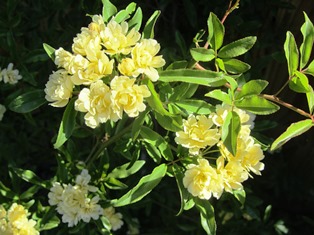
Lady Banks is a species rose named after the wife of Sir Joseph Banks, legendary head of the Royal Horticultural Society of Great Britain
Climbing Lady Banks scampers up our chicken house wall and explodes into a profusion of hundreds of disease-resistant yellow roses on long canes without thorns. This rose is not a hybrid, but rather comes from China and has been cultivated since 1796. To say it spreads is an understatement–the largest Lady Banks grows in Tombstone, Arizona where it covers 8,000 square feet.
Climbing Sally Holmes is a showoff in our garden. The pointed-shaped buds start out cream-colored (tinged in pink) and then open into an white bloom with a light, sweet fragrance. The rose can climb 12 feet, the height ours has reached where it grows along the back fence.
The vigor of Sally Holmes means it can easily be grown from cuttings. In fact our massive climber was grown from an arm-length cutting dusted with root hormone that we stuck in the ground three years ago. We’ve taken many cuttings since to start the climber elsewhere on our property.
If you have the space for climbers, consider giving one or more a try. Although they are hardy, often disease-resistant, and reward with spectacular displays of bloom, they need support, so think pillars, arbors, gazebos, porch railings, and fences.
 Facebook
Facebook Goodreads
Goodreads LinkedIn
LinkedIn Meera Lester
Meera Lester Twitter
Twitter




